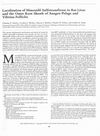TLDR Rat skin can convert minoxidil into its active form, aiding hair growth.
The study investigated the activity of minoxidil sulphotransferase (MST) in rat skin and liver, finding that MST in rat skin is similar to the P-form of phenolsulphotransferase (PST) in human tissues. The research demonstrated that rat skin could synthesize 3'-phosphoadenosine-5'-phosphosulphate (PAPS) from inorganic sulphate and use it to produce minoxidil sulphate, the active metabolite of minoxidil. This suggested that the skin itself could facilitate minoxidil's hair growth-promoting effects without relying on the liver or other organs.
 16 citations
,
May 1992 in “Journal of Investigative Dermatology”
16 citations
,
May 1992 in “Journal of Investigative Dermatology” Minoxidil sulfotransferase is a marker of keratinocyte differentiation and may play a role in hair growth.
82 citations
,
March 1992 in “Journal of Investigative Dermatology”  46 citations
,
January 1991 in “Journal of Investigative Dermatology”
46 citations
,
January 1991 in “Journal of Investigative Dermatology” Minoxidil works in liver and outer hair root sheath for hair growth.
 166 citations
,
November 1990 in “Journal of Investigative Dermatology”
166 citations
,
November 1990 in “Journal of Investigative Dermatology” Minoxidil sulfate stimulates hair growth.
 29 citations
,
September 1990 in “Biochemical Journal”
29 citations
,
September 1990 in “Biochemical Journal” Enzyme purified and characterized for minoxidil sulphation in rat liver.
 68 citations
,
September 1990 in “Biochemical Pharmacology”
68 citations
,
September 1990 in “Biochemical Pharmacology” Minoxidil activates hair growth by being sulfated by P-PST in the human liver.
 39 citations
,
November 1987 in “Clinica Chimica Acta”
39 citations
,
November 1987 in “Clinica Chimica Acta” Human platelets change minoxidil to minoxidil sulfate, helping blood vessels widen.
 August 2023 in “Journal of Cosmetic Dermatology”
August 2023 in “Journal of Cosmetic Dermatology” Some plants like spinach, broccoli, and matcha may boost the effectiveness of the hair growth drug minoxidil.






